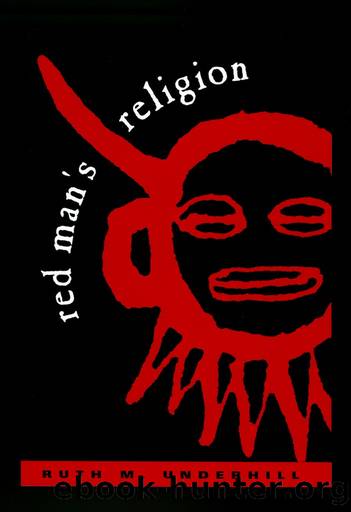Red Man's Religion by Ruth Murray Underhill

Author:Ruth Murray Underhill [Underhill, Ruth Murray]
Language: eng
Format: epub
Tags: Social Science, General, Anthropology, Cultural & Social, History, Indigenous Peoples of the Americas
ISBN: 9780226217680
Google: EC6GDwAAQBAJ
Barnesnoble:
Publisher: University of Chicago Press
Published: 1972-09-15T00:00:00+00:00
Map IV Extended Culture Areas Planting in North America
Outside the center were the fields and dwellings of the farmers. These had a somewhat different pattern in highland country or in lowland, a pattern which was continued as the plants moved north. In the treeless high country, workersâ dwelling could cluster around the center. Beyond were the fields usually watered by irrigation from river or lake. The Aztecs had some gardens actually in a lake. In the forested lowlands, planters used the ancient worldwide system of slash-and-burn. This meant girdling the trees with stone axes, allowing them to die, then burning the brush and planting in the ashes. After some years, rain washed away the mineral-rich ashes, underbrush grew up, and the fields had to be abandoned. Thus they and the peoplesâ dwellings moved farther from the cityâs center.
The Mexican cities grew rich. They developed social classes, as we can tell from the rich funeral goods given to certain individuals. Our accounts of daily life and ceremony in such cities are all proto-historic; still, the Aztecs, from whom the fullest accounts came, insisted that they were following ancient customs. These accounts tell of a trained priesthood containing several degrees. They tell of a warrior class wearing special insignia and giving public performances.
There was a calendric round of ceremonies, many of them seeming glorified examples of firstfruit rites. Several honored the corn at different stages of growth. Others appealed to the rain gods, of whom there were many, living on the mountain tops. These Tlalocs had a chief and perhaps four principal gods living in the four directions. They ruled a green paradise which was one of the Aztec afterworlds. Also there were gods of fire, of war, of death, of the wind, and of the arts. There was an earth goddess and an all-knowing deity who was almost a Supreme Being.
The Aztecs paid honor to these divinities with magnificent processions and dances. In their temples they kept undying fires which were renewed at stated intervals. They burned a kind of incense made of copal gum. Sometimes all the people fasted; they drew blood from their tongues and ears. But the outstanding tribute to the spirits was human sacrifice. In the Old World, too, most planting people ritually killed human beings, perhaps as a re-enactment of the yearly death and rebirth of vegetation. The Aztecs killed a man and stripped off his skin as symbolic of the husking of corn, and they sent weeping children as messengers to the rain gods. Their mass killings, however, were a gift to the sun. In their belief the orb was not a supreme being but one of the early gods, given power from the bodies and the blood of many other gods. Therefore, a constant stream of blood was needed to keep him on his rounds. They fought their battles largely to get prisoners who would supply it.
Aztecs, the late comers to Mexico, were the most violent in their cult of human sacrifice but we gather that this way of pleasing the Supernatural was common all over Middle America.
Download
This site does not store any files on its server. We only index and link to content provided by other sites. Please contact the content providers to delete copyright contents if any and email us, we'll remove relevant links or contents immediately.
| Baha'i | Cults |
| Demonology & Satanism | Eckankar |
| Egyptian Book of the Dead | Freemasonry |
| Messianic Judaism | Mysticism |
| Scientology | Theism |
| Tribal & Ethnic | Unitarian Universalism |
The Four Agreements by Don Miguel Ruiz(6552)
Breaking Free by Rachel Jeffs(4121)
The Hatha Yoga Pradipika (Translated) by Svatmarama(3189)
120 Days of Sodom by Marquis de Sade(3125)
Member of the Family by Dianne Lake(2284)
The Tao of Physics by Fritjof Capra(2209)
The Psychedelic Gospels: The Secret History of Hallucinogens in Christianity by Jerry B. Brown(2097)
The Road to Jonestown by Jeff Guinn(2002)
Going Clear: Scientology, Hollywood, and the Prison of Belief by Lawrence Wright(1912)
Going Clear by Lawrence Wright(1897)
Uriel's Machine by Christopher Knight(1846)
The Grand Grimoire: The Red Dragon by Author Unknown(1739)
The Gnostic Gospel of St. Thomas by Tau Malachi(1715)
Key to the Sacred Pattern: The Untold Story of Rennes-le-Chateau by Henry Lincoln(1577)
The Malloreon: Book 02 - King of the Murgos by David Eddings(1536)
Waco by David Thibodeau & Leon Whiteson & Aviva Layton(1511)
The New World Order Book by Nick Redfern(1509)
The Secret of the Temple by John Michael Greer(1446)
Animal Speak by Ted Andrews(1428)
